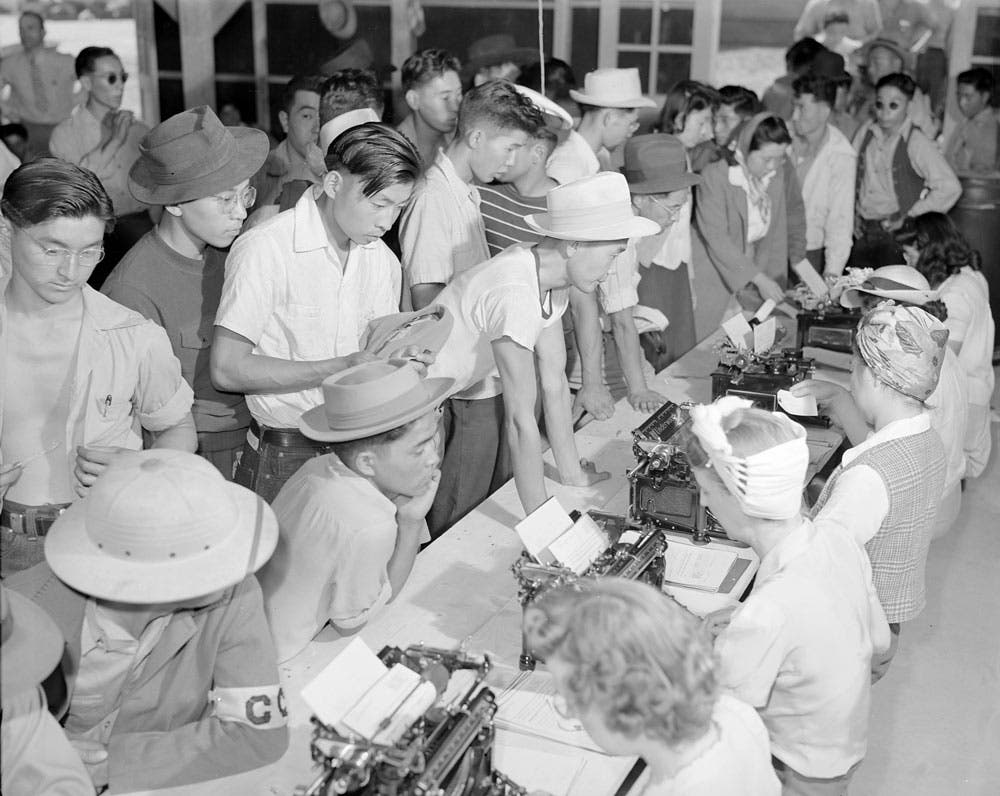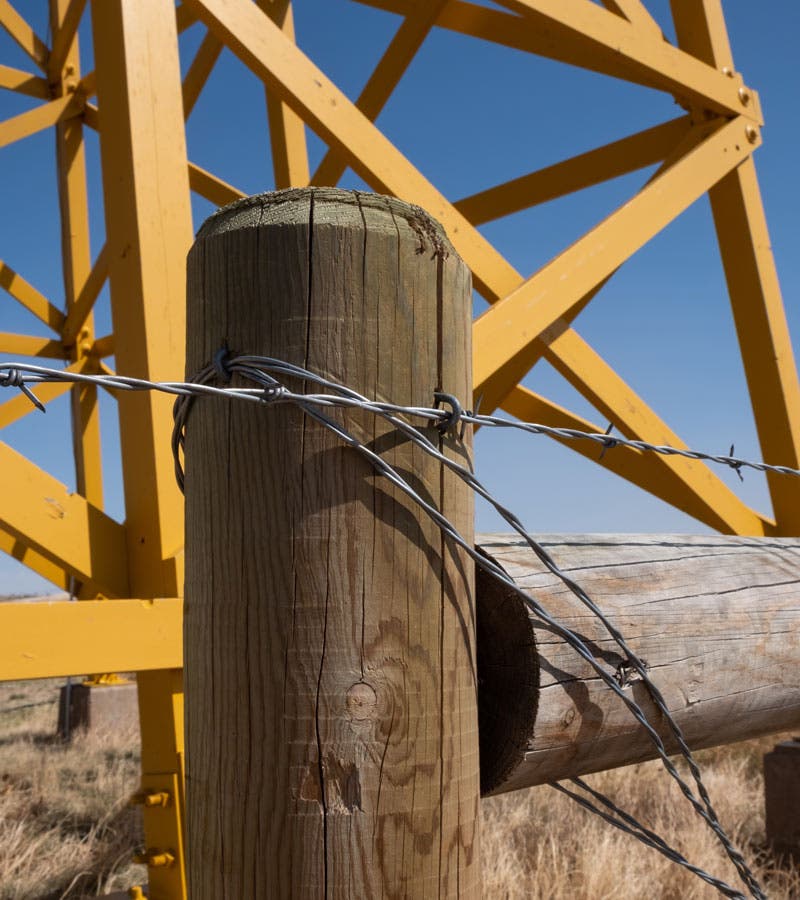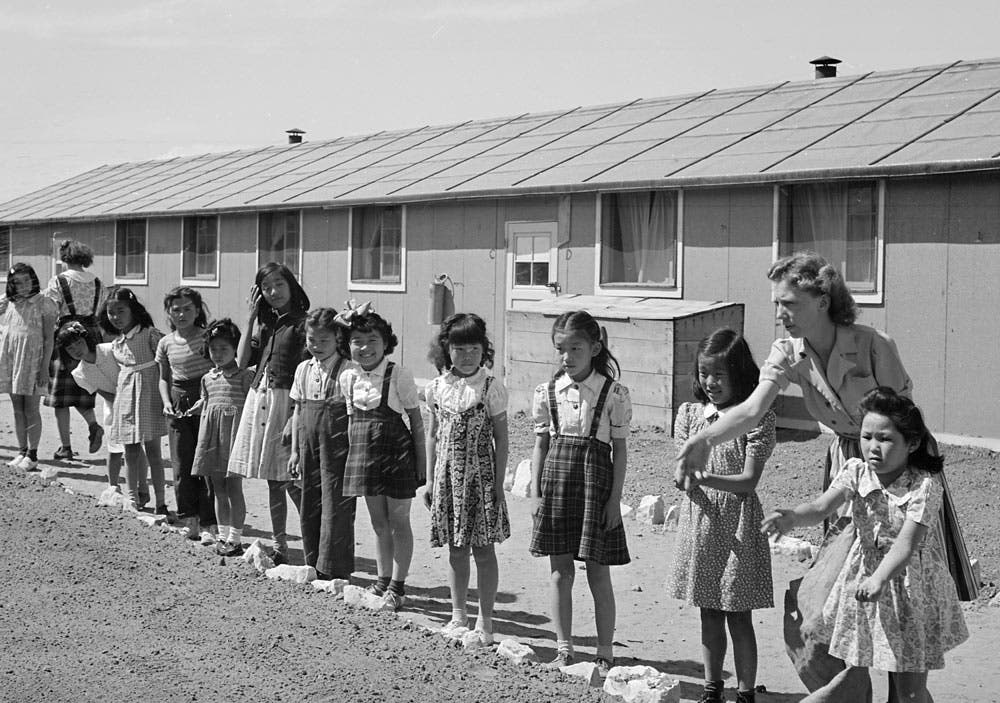Remembering Amache, a Japanese Internment Camp in Colorado

Amache Japanese Internment Camp in Colorado (Photo: Mikaela Ruland)
As my husband and I pull of Hwy. 50 near the tiny town of Granada in rural southeastern Colorado and bump down a dirt road, it’s hard to imagine that anyone ever lived here, let alone thousands.
From a distance, the only signs of humans are a lone yellow-and-white checkered water tower on the horizon. And, when I look critically, the trees. As we drove the county roads to get here, the only trees adorning the windswept plains followed creek beds and were old, gnarly cottonwoods. As we drive past the faded sign for Amache, small trees dot the landscape everywhere, their leaves just beginning to appear on a spring afternoon.
These trees were planted by the Japanese and Japanese American internees at the Granada Relocation Center, otherwise known as Amache. We’re the only ones there, and I imagine it would be eerily quiet if it wasn’t for the howling wind. We start the audio tour and get out of the car at our first stop. The voice of a survivor of Amache guides us through the sagebrush and yucca, around several cacti and suddenly, there are traces of those who were imprisoned at Amache all around.
On February 19, 1942, amidst World War II, President Franklin D. Roosevelt issued Executive Order 9066 authorizing the internment of more than 100,000 people residing along the West Coast of the United States with Japanese ancestry. Most of these people were American citizens.

Japanese and Japanese Americans were rounded up and forced to leave their homes, businesses and livelihoods. They were allowed to take few possessions and left most of their lives, including pets, behind. The exclusion zone in which they were removed from included most of the western half of Washington and Oregon, all of California and Alaska, southern Arizona and some of Hawaii. Many were put in temporary holding or “assembly” centers that were not designed to house people such as the Santa Anita Racetrack where families were kept in horse stalls. Eventually 110,000 – 120,000 people were moved into 10 internment camps, called “relocation centers,” in desolate parts of the country’s interior.
The term most often used to describe this event is “internment,” but it’s a carefully chosen term that doesn’t hold the same emotional response as other words that mean the same thing. “Imprisonment” is a synonym for “internment” and the “relocation centers” or “internment camps” were in fact concentration camps.
Barbed wire fences surrounded prison-style barracks. Armed guards sat in towers watching the camps. Prisoners slept on cots.
One such camp was Amache.

Colorado’s governor at the time, Ralph Lawrence Carr, was the only elected official to publicly denounce the imprisonment, but the U.S. government still built Amache, and Carr lost his re-election in 1943.
Amache covered one square mile and imprisoned more than 7,000 Japanese and Japanese Americans between 1942-45. The audio tour takes us past the crumbling foundations of barracks, a high school, mess halls, latrines. We stop at a replica barrack, and I’m astounded by how small it is. Each tarpaper-roofed barrack was divided into six apartments, each equipped with a coal-burning stove, Army cots and a single bare lightbulb. The largest apartments, for families with multiple children, were 20×24 feet. Communal toilets and showers offered no privacy.
Despite the horrible circumstances, the prisoners of Amache were resilient. They made the best of their terrible situation. Prisoners made furniture and decorations for their apartments. They planted trees and gardens, many of which are still flourishing, more than 70 years later. We pass the remains of a koi pond, stocked with carp and catfish from the nearby Arkansas River.
The prisoners created a recreation program with sports like baseball and basketball and held adult education classes in everything from paper flower arranging to weaving to poetry and created a newspaper. Children went to school and the adults helped run the camp from the mess hall to the hospital to the silk screen shop.

The biggest industry at Amache was agriculture. Prisoners grew almost all of the food eaten at Amache. Many crops that had never been grown in the area were cultivated like potatoes, mung beans and daikon. Those crops still are grown in the area today. A canning plant allowed the prisoners to preserve summer produce. Amache’s thriving agriculture helped them provide for other internment camps and even the U.S. military.
Leave programs were established at Amache allowing some prisoners to do agricultural work nearby, attend university or serve in the military. Despite the U.S. government forcibly removing them from their homes and imprisoning them, 953 Japanese Americans from Amache served in the military.
In 1945, when Amache closed, most of the prisoners had nowhere to return. Their property had been sold, their businesses had been looted or destroyed. Having only been allowed to bring as many possessions as they could carry, their material life on the West Coast was gone. Many chose not to return. Denver became the second biggest resettlement community outside the West Coast.
The Hommas were one of the hundreds of families detained at Amache. Dr. Homma was a dentist with a thriving practice in Southern California with movie stars as patients. Their family was detained in a horse stall at the Santa Anita Racetrack before being moved to Amache where medical staff was needed.
“Like most parents, they [my grandparents] did an incredible job shielding the children from all the hardships of their new life behind barbed wire,” says Mitch Homma, Dr. Homma’s grandson in a talk hosted by National Parks Conservation Association. “[My] dad remembers playing along the barbed wire fence and climbing the 72-foot-high water tower.”
I look up at the water tower, sharply contrasting against the brilliant blue sky and imagine what it must’ve been like to be a kid growing up behind barbed wire. When a new high school was built at Amache, which had practically overnight become the 10th largest city in Colorado, nearby residents and politicians were outraged that money would be spent on a large new high school for the internees. The high school, like all the buildings at Amache, was flimsy and built of temporary walls but the surrounding communities didn’t care. The planned elementary and junior high school were never built because of protests, and the younger students learned in barracks.
In 1944, Dr. Homma died of a heart attack and stroke at Amache at 44 years old after losing almost 30 pounds. That winter, the family struggled to heat their room because they couldn’t gather enough coal. Mrs. Homma had nothing to return to in Southern California when she was released, so she took her children to Seattle where they lived in a church parsonage for 10 years before they saved up enough to purchase their own home.
Amache’s peaceful cemetery is an oasis in the otherwise harsh prairie. Large pine trees block the wind and green grass grows amongst the grave markers. A wrought iron fence keeps the hoards of tumbleweeds out of the grounds and a blossoming tree is putting on blush pink buds. A pair of doves swoops by, startled by our presence. The improvements to the cemetery are new, completed by local students from Granada High School known as the Amache Preservation Society (APS).
Started by social studies teacher John Hopper, who is now the high school principal, APS maintains Amache, has restored the buildings that stand today, runs the Amache Museum in Granada, seeks out and writes grants to fund Amache and more. The organization is comprised entirely of high school students.
Derek Okubo’s father and grandparents were also detained at Amache. They owned a store and home in Eagle Rock, Calif. before being detained at Santa Anita and moved to Amache. Derek’s father spent ages 13-16 in the camp. His family moved to Denver upon release where they opened a store, Ben’s Super Market on 28th Ave., that still stands today. Later in life, Derek’s father became involved with the preservation of Amache and ensuring the history of internment was told. A teacher called Derek’s brother a liar when he talked about internment at school and that lit a fire under Derek’s father to champion education and preservation.
When Derek’s father passed away in 2001, Derek was recruited by the Denver Central Optimists to continue his father’s work. In 2005, he lobbied to make Amache a National Historic Site and in 2011 he was appointed Executive Director of the Agency for Human Rights and Community Partnerships for the City and County of Denver. Today, he’s working with a diverse group to help Amache gain national park site status, including the University of Denver Amache Project, the Amache Preservation Society and the National Parks Conservation Association.
“These unconstitutional atrocities must never be forgotten, and in many instances their unfortunate legacy continues today,” said Colorado Gov. Jared Polis in a letter to the Mile High Japanese American Citizens League. “Great nations can make terrible mistakes, but it is only through the acknowledgement of their terrible mistakes —the learning from, and rectification of those mistakes — that nations can achieve true greatness. By preserving Amache and similar sites, we promote healing and reconciliation on not only a national level, but on personal and community levels as well.”
In March 2022, President Biden signed the Amache National Historic Site Act into law, bringing this important location from American history under the umbrella of the National Park Service. In February 2023, Secretary Haaland officially established it as a national park site.
“To this day, most of our schools do not teach this history,” reflects Tracy Coppola, National Parks Conservation Association’s Colorado Program Manager in a NPCA blog. “Yet Amache is an American story that must not be forgotten. It is a story of failure by the U.S. government to protect its own citizens. And it is a story that still resonates today with the current political climate of anti-immigration rhetoric and the divisiveness it creates.”
As we leave for the day, I realize we’ve only seen two other cars all afternoon. I’ve lived in Colorado my entire life and until recently, I never knew Amache existed. While local organizations have done an amazing job working to keep the site’s history alive, there’s so much more that could be done. The history of Amache and Japanese internment must be remembered if we’re going to move forward in creating a more equitable America.